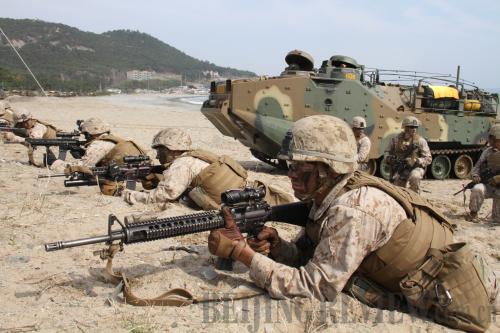|
 |
|
TEAM U.S.-SOUTH KOREA: Soldiers take part in a U.S.-South Korea joint military exercise on March 31 in South Korea's Pohang (SONG CHENGFENG) |

U.S. President Barack Obama started an Asia tour on April 23, covering Japan, South Korea, Malaysia and the Philippines. While his voyage conspicuously does not include China, it is undeniable that the United States is no longer able to undertake Asian agendas to the exclusion of China.
Reassuring allies
Obama's journey in April connects a handful of Washington's most important allies in Asia, and runs across the South China Sea and the East China Sea, where disputes have simmered over territory and maritime rights. Japan and South Korea, which have both hosted Obama twice, have proved themselves as important allies in the U.S. Asia-Pacific alliance system. The U.S. president also included two Southeast Asian nations in his tour, showing a clear intention to draw the Association of Southeast Asian Nations to the U.S. side. The four countries are important to the U.S.-headed Trans-Pacific Partnership. Malaysia and Japan now are at a key stage of bilateral consultations with the United States over the free trade pact, while South Korea and the Philippines have decided to join in negotiations.
Obama previously paid three trips to Asia as U.S. president, visiting China, Japan, South Korea, India, Indonesia, Thailand, Myanmar and Cambodia.
Considering China's rise as one of the top strategic challenges Washington must confront, the Obama administration has worked to sustain the power balance in the Asia-Pacific via its "pivot to Asia" policy in the past three years. Although Washington has reiterated that China is not the target of this policy, China remains suspicious. Many Chinese observers believe Washington's rebalancing policy has been divided into two parts: The first is to conduct cooperation with China to revive the U.S. economy and manage global affairs by relying on China's growing influence; and the second is to set boundaries for China's development so as to prevent the rising power from replacing the United States as the world's No. 1.
Japan and the Philippines are eager to drag Washington to their sides, so as to gain some leverage when confronting China over their territorial disputes respectively in the East and South China Seas. Although the Obama administration has tried to avoid choosing sides in the disputes, it publicly opposed China's decision to implement an air defense identification zone and questioned the legitimacy of China's U-shape "nine-dash line" in the South China Sea. It claimed that the way China declared sovereignty had damaged regional stability, and provided backstage guidance and coordination when its two allies confronted China in the air and at sea.
During Obama's April tour, the U.S. president will face further pressure from Japan and the Philippines for increased support. The United States is now in a dilemma over how to efficiently sustain its Asia-Pacific alliance system without provoking China while preventing direct conflicts in disputed areas. Japan's future direction is also a problem for the United States. Japanese Prime Minister Shinzo Abe is accelerating the country's pace of moving politically rightward. He actively pushed to amend Japan's peaceful Constitution, and has sworn to rebuild a strong and powerful Japan.
Abe's strategy is to continuously rely on the Japan-U.S. alliance, while at the same time gaining an upper hand in handling international affairs. Japan has even started to say "no" to Washington on big issues. The United States has missed its best opportunity to deal with Japan's historical wrongdoings after World War II. The White House needs to worry that once Japan uses its alliance with the United States to realize its "normalization," it will eventually abandon the alliance and become a power that challenges U.S. dominance in the West Pacific region.
Another goal of Obama's April tour is to ameliorate the relationship between Japan and South Korea, which has been tense due to their territorial disputes over the Dokdo Islands (known as the Takeshima Islands in Japan) and Abe's visit to the Yasukuni Shrine, where 14 Class-A war criminals of World War II are honored along with the Japanese war dead. The two East Asian neighbors previously waged a diplomatic war over being Obama's No. 1 visiting priority. In the end, Obama decided to stay only two nights in Tokyo, making the trip the shortest state visit a U.S. president has made to Japan. Previously, Washington held a trilateral meeting of U.S., Japanese and South Korean leaders in The Hague during the Third Nuclear Security Summit in March, and tried to break the ice between its two allies.
Rethinking Asia policy
The White House planned to use Obama's Asia tour to display U.S. commitments to strengthening contacts with Asia-Pacific nations in diplomatic, economic and security fields. However, it now has to rethink the tour's value due to the changed international situation.
| 